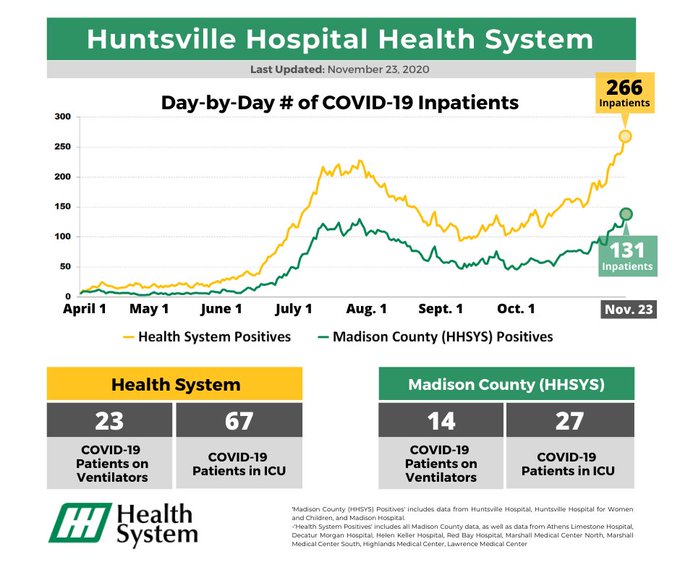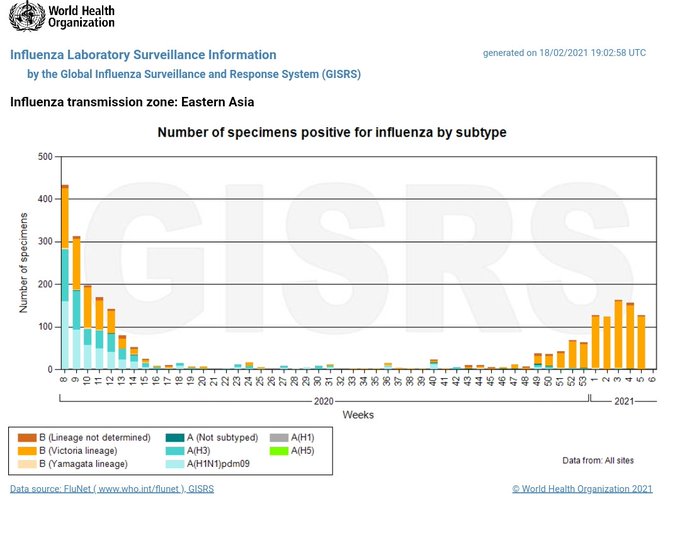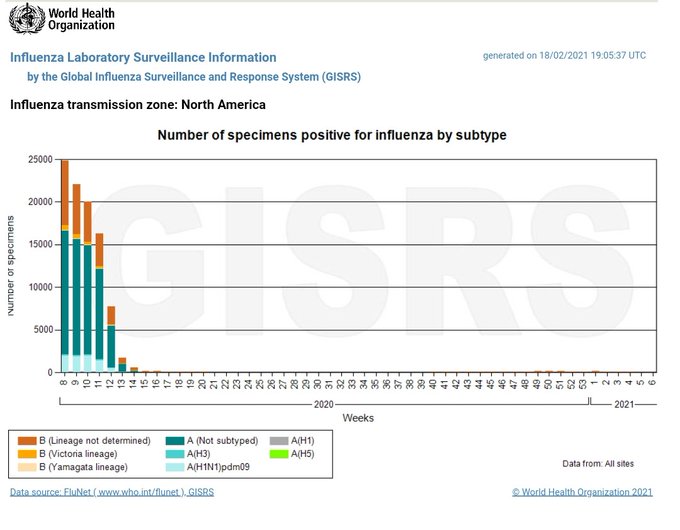I tried 4 different stores in the Shoals area and refreshed the page several times for each and I never got a chance to schedule an appointment. It's says there are no appointments available any day thru Thursday next weekI had a friend that was able to book an appointment for 6:40 a.m. one day next week. They'll be getting started early!
Navigation
Install the app
How to install the app on iOS
Follow along with the video below to see how to install our site as a web app on your home screen.
Note: This feature may not be available in some browsers.
More options
-
Welcome to TalkWeather! We see you lurking around TalkWeather! Take the extra step and join us today to view attachments, see less ads and maybe even join the discussion. CLICK TO JOIN TALKWEATHER
You are using an out of date browser. It may not display this or other websites correctly.
You should upgrade or use an alternative browser.
You should upgrade or use an alternative browser.
COVID-19 detected in United States
- Thread starter WesL
- Start date
- Moderator
- #962
I tried 4 different stores in the Shoals area and refreshed the page several times for each and I never got a chance to schedule an appointment. It's says there are no appointments available any day thru Thursday next week
They probably have maxed out appointments. I'd keep trying and hopefully one will come up sooner rather than later.
- Moderator
- #963
I got an email from the university tonight saying that said I was eligible for a vaccine through the partnership with UNA and North Alabama Medical Center. I’ll cancel one but I went from having little prospect to two in 24 hours.
Unfortunately, Biden and the CDC seem beholden to Teachers Unions when it comes to schools. So much for following "the Science".
You know it is pretty bad when VOX of all outlets puts this piece out

 www.vox.com
www.vox.com
You know it is pretty bad when VOX of all outlets puts this piece out

I’m an epidemiologist and a father. Here’s why I’m losing patience with our teachers’ unions.
The evidence is clear: We can open schools safely now.
gangstonc
Member
Yes. If the feds will provide funding to the schools, this can be done safely. It can’t be done without funding and a plan, but it’s not insurmountable by any means.Unfortunately, Biden and the CDC seem beholden to Teachers Unions when it comes to schools. So much for following "the Science".
You know it is pretty bad when VOX of all outlets puts this piece out

I’m an epidemiologist and a father. Here’s why I’m losing patience with our teachers’ unions.
The evidence is clear: We can open schools safely now.www.vox.com
Yes. If the feds will provide funding to the schools, this can be done safely. It can’t be done without funding and a plan, but it’s not insurmountable by any means.
I disagree that anything new needs to happen to open schools. Some enhancements could be added over the coming months, but schools should already be open full time, in person, everywhere in the country.
gangstonc
Member
I agree with that too. But children need masks. Each teacher needs a thermometer. What to do if there is an outbreak at the school. Little things like that.I disagree that anything new needs to happen to open schools. Some enhancements could be added over the coming months, but schools should already be open full time, in person, everywhere in the country.
It baffles me how prolific people can put out just straight up lies like this and people believe it. This is a former CDC director spouting something that he knows is a lie. (the lie being the second part. The part about vaccinations not having much of an effect yet is true)
gangstonc
Member
It baffles me how prolific people can put out just straight up lies like this and people believe it. This is a former CDC director spouting something that he knows is a lie. (the lie being the second part. The part about vaccinations not having much of an effect yet is true)
I don’t get it.
I don’t get it.
The following quote is a lie "Cases are coming down because of what we're doing right: staying apart, wearing masks, avoiding travel, and not gathering with others indoors. Let's keep it up.".
That's not why cases are coming down. None of those things have changed significantly from when the virus was exploding. It's a seasonal respiratory virus, following roughly the same pattern that would be expected of a seasonal respiratory virus. I'm not arguing those things hurt, but those variables haven't changed much, yet the virus activity across the US is decreasing rapidly, ergo they aren't the reason for the decrease.
Last edited:
I think there are several factors in play for the reduced number of cases. I don't see what the Dr. says as being a lie. Masks, distancing, etc have a big effect on reducing the spread. We also haven't had any "gathering" holidays since New Years and to me that may be the biggest difference. The Thanksgiving, Christmas, New Year's spikes have played out. Add that to 20% of Alabama's population have had the virus or have been vaccinated which reduces the pool of those who would be vulnerable.
I think there are several factors in play for the reduced number of cases. I don't see what the Dr. says as being a lie. Masks, distancing, etc have a big effect on reducing the spread. We also haven't had any "gathering" holidays since New Years and to me that may be the biggest difference. The Thanksgiving, Christmas, New Year's spikes have played out. Add that to 20% of Alabama's population have had the virus or have been vaccinated which reduces the pool of those who would be vulnerable.
Mask usage and distancing haven't significantly changed over the last few months, crediting a variable for a drop that was also in place during the rise is misleading at best.
I strongly disagree with your second point. The gatherings you reference simply fell during the time while the virus was rapidly spreading, they were not the cause of the rise. They may have enhanced the rise slightly, but those gatherings were little more than noise in the overall signal. Why was virus activity decreasing throughout the holidays across the plains, rockies, and upper midwest? Their peak was just as high per capita as it was in the southern US, but it came before the holidays. Here's a plot of some of those states and Thanksgiving/Christmas plotted on it

Even in Alabama, cases and hospitalizations started increasing rapidly in late October. Up in your area, northern Alabama rapidly increased throughout all of November. Here's data from the Huntsville Hospital system from the Monday before Thanksgiving. (this value also increases to 307 by Dec 1, and that's likely before any supposed Thanksgiving increase would be seen)

I do agree that the combination of the amount of people that have had it and people getting vaccinated are likely contributing to the rapidness at which it is currently decreasing.
Last edited:
gangstonc
Member
Is it possible that the population can only sustain a certain amount of Covid, then at that point people change their behavior?
Is it possible that the population can only sustain a certain amount of Covid, then at that point people change their behavior?
I would say it is highly unlikely, given how uniform it is from region to region, state to state. Mobility data doesn't suggest any significant changes in behavior either.
I won't claim to know the reasons for why respiratory viruses suddenly start receding after climbing for months, in short because well, I don't know why. RSV, the flu, and other coronaviruses follow roughly the same patterns every year though.
gangstonc
Member
That’s very interesting. I appreciate all the effort you have put into this thread.I would say it is highly unlikely, given how uniform it is from region to region, state to state. Mobility data doesn't suggest any significant changes in behavior either.
I won't claim to know the reasons for why respiratory viruses suddenly start receding after climbing for months, in short because well, I don't know why. RSV, the flu, and other coronaviruses follow roughly the same patterns every year though.
That’s very interesting. I appreciate all the effort you have put into this thread.
I've spent way too much time this past year analyzing data on COVID, unfortunately. I do apologize if I've come across a bit rude at times. I'm obviously quite confident in my opinions/thoughts on the subject and I'm good with numbers, but not with words, ha.
gangstonc
Member
I think you’ve done a fantastic job.I've spent way too much time this past year analyzing data on COVID, unfortunately. I do apologize if I've come across a bit rude at times. I'm obviously quite confident in my opinions/thoughts on the subject and I'm good with numbers, but not with words, ha.
Here's something interesting, in the parts of the world where there is very little COVID, the flu is circulating again (albeit, lower than previous years). This is mainly in SE Asia and East Asia. I think this lends a lot of credibility to the theory that the flu has been chased out by COVID for the time being.
Here's flu activity in East Asia vs. North America


Here's flu activity in East Asia vs. North America


- Admin
- #980
- Messages
- 2,320
- Reaction score
- 1,989
- Location
- Meridianville, Al
- Special Affiliations
- SKYWARN® Volunteer
Chased out by COVID or reduced by anti-COVID measures that have been in place for months such as masks, social distancing, staying home, etc.
